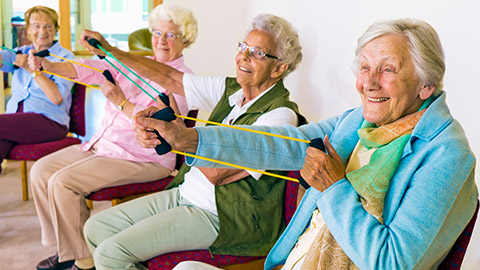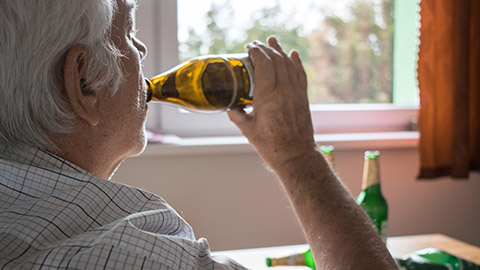In this section, we shift gears from managing health issues to active prevention. As support workers, you are the champions of well-being. We'll explore key strategies – vaccines, healthy eating, physical activity, lifestyle changes, and continuous education. This is your guide to fostering a culture of prevention and creating a healthier, happier environment for aged care residents. Let's dive in.
As individuals age, their immune system weakens, rendering them more susceptible to illnesses. Moreover, the effectiveness of previous vaccinations diminishes over time. It is important to adhere to the New Zealand Immunisation Schedule to safeguard residents against preventable diseases. Getting vaccinated not only protects residents themselves but also protects the community and people who cannot get vaccinated.
Vaccines function by triggering the development of protective antibodies, bolstering a person’s immune defences. Vaccinations protect you from illness by helping build protective antibodies in your bloodstream. By building immunity before exposure to an illness, you have a better chance of not getting sick.
Many illnesses are preventable if vaccines are received at the correct time. According to the World Health Organisation, immunisation prevents 2-3 million deaths each year from preventable diseases such as influenza, measles, and tetanus.
Note down all the vaccines available to people over the age of 65.
Activity
Watch the video about the flu vaccine and answer the questions below.

Understanding the link between healthy eating and disease prevention is paramount in supporting the well-being of older adults in aged care. Good nutrition throughout one's life is a powerful preventive measure against chronic diseases, and the positive news is that it's never too late to adopt healthier habits for robust aging. Older adults face an increased risk of chronic conditions like heart disease, diabetes, and issues related to changes in muscle and bone mass, such as osteoporosis.
Despite having lower calorie needs, older adults often require similar or increased nutrient intake compared to their younger counterparts due to factors like reduced physical activity, metabolic changes, and age-related bone and muscle loss. Additionally, the nutrient needs of this population are influenced by chronic health conditions, medication use, and changes in body composition. Therefore, emphasising a healthy dietary pattern becomes crucial, making every bite count in promoting optimal health for older adults in your care.
Let's take a look at the specific connection between nutrition and the treatment and prevention of prevalent chronic diseases affecting our aged care residents.
Treatment: Adequate protein intake for tissue repair, sufficient vitamins, and minerals. Low fat diets to reduce weight gain.
Prevention: Ensure residents receive a well-balanced diet rich in protein and nutrients to maintain skin integrity. Maintain a healthy body weight.
Treatment: Carbohydrate management, portion control, and monitoring blood sugar levels. Limit saturated/trans fats, sodium and added sugars.
Prevention: Promote a diet with controlled carbohydrates, emphasising whole foods and consistent meal timings. /p>
Treatment: Adequate calorie and protein intake for respiratory muscle support.
Prevention: Encourage a balanced diet to maintain overall health, supporting respiratory function.
Treatment: Identifying and avoiding trigger foods, maintaining optimal weight.
Prevention: Promote an anti-inflammatory diet rich in fruits, vegetables, and omega-3 fatty acids.
Treatment: Low-sodium diet, control of saturated fats and cholesterol.
Prevention: Encourage heart-healthy choices, including a diet rich in fruits, vegetables, and whole grains.
Activity - Quiz
Now you have an understanding of how to include nutrition as a treatment and prevention for common health problems. Use the Eating for Healthy Older People resource produced by Te Whatu Ora Health New Zealand to answer the following multi-choice questions.

Reflection
Take a moment to reflect on what physical activities you currently engage in and how they contribute to your daily life and well-being.
Why is Physical Activity Essential for Aged Care Residents?
- Prevent and manage health conditions: For aged care residents, regular physical activity is not just about maintaining physical health but is crucial for preventing common health issues. Physical activity can reduce the risk of cardiovascular disease and respiratory issues, prevent type 2 diabetes and protect against various cancers. Additionally, it aids in weight and cholesterol control, improves muscle mass and bone density, and contributes to better balance and strength, decreasing the risk of falls.
- Recovery: Engaging in a prescribed exercise programme after a medical event, often guided by physical therapists or occupational therapists, aids in the healing process and helps prevent further injuries.
- Improving Mood: Having a consistent exercise programme goes a long way in avoiding physical decline, enhancing mobility, and improving the general mood of seniors. This is particularly vital to their mental well-being. It also improves sleep.
- Promoting social engagement: Beyond physical health, engagement in physical activities fosters social connections among residents. It increases a sense of independence, providing seniors with a purpose and contributing significantly to their overall quality of life.
- Independence and Functional Abilities: Engaging in activities that enhance strength, balance, and flexibility contributes to maintaining independence in daily activities. This is crucial for preserving functional abilities and reducing the reliance on external assistance.
Types of Recommended Physical Activity for Seniors in Aged Care Facilities
Physical activity is any movement of the body that uses energy.Ministry of Health NZ
The Ministry of Health NZ advocates for at least 30 minutes of daily gentle to moderate exercises for older adults. These exercises should be sufficiently intense to elevate the heart rate slightly and induce a mild shortness of breath, allowing residents to talk comfortably but not sing.
The choice of physical activity for aged care residents depends on factors such as age, capability, and health. This implies that recommended activities range from breathing exercises to modified group fitness classes like yoga and Pilates, ensuring suitability for the unique needs of aged care residents.
While some seniors may be capable of vigorous exercise, characterised by an elevated heart rate and difficulty in maintaining a conversation, it's generally not recommended, especially for those unaccustomed to such intensity.
Aim for at least 30 minutes of physical activity that makes breathing and heart rate increase (aerobic activity) five days a week.
- Moderate intensity activities: Cause a slight but noticeable increase in breathing and heart rate. You can chat during moderate-intensity activity.
- Vigorous intensity activities: Significantly raise breathing and heart rate. You are not able to chat during vigorous-intensity activity.
The following types of physical activities are recommended for seniors living in aged care facilities:
Specific exercises targeting the core, back, shoulders, and knees can enhance strength and movement, promoting independence. Some facilities offer group exercise programmes focusing on joint mobility.
A low-impact form of exercise, stair climbing, cycling, outdoor walking.
Leveraging the buoyancy and resistance of water, aqua aerobics is an ideal exercise for maintaining fitness and building strength while being gentle on joints. Availability depends on whether the facility has a hydrotherapy pool.
Exercise physiologists, trained to deliver tailored exercise programmes, offer sessions adapted to individual needs. Aged care facilities often host Allied Health Professionals who conduct these classes throughout the week.
As seniors age, joints and muscles may become tender. Stretching exercises, either individually or in group classes, can alleviate tension and enhance flexibility, reducing the risk of injuries.
Lifting weights or engaging in strength training exercises is beneficial for improving muscle mass, enhancing balance, and reducing the risk of falls. Strong muscles also contribute to the prevention of conditions like osteoporosis and osteoarthritis.
Activity - Documentation
Use the documentation tool provided to answer the questions provided.
The following activities are examples of physical activity for older people recommended by the Ministry of Health, NZ. Read more about the Guidelines on Physical Activity for Older People.
| Moderate intensity | Vigorous intensity |
|---|---|
| Cycling | Walking uphill |
| Golf | Heavy digging |
| Brisk walking | Fast lane swimming |
| Housework | Cycling (more than 16km)/td> |
| Kapa haka | Fast dancing |
| Kaumatua line dancing | |
| Stair climbing | |
| Swimming | |
| Walking | |
| Waka ama | |
| Playing with grandchildren | |
| Water aerobics |
Aim to do three sessions of flexibility or balance activities and two sessions of resistance activities per week.
| Resistance | Flexibility | Balance |
|---|---|---|
| Carrying shopping | Ankle stretches | Bowls |
| Chair raises | Bowls | Chair raises |
| Cycling | Gardening | Cycling (over 16km |
| Golf | Golf | Golf |
| Hillwalking | Housework | Tai chi |
| Knee lifts | Kilikiti | Otago exercise programme |
| Tai chi | Tai chi | Petanque |
| Stair climbing | Otago exercise programme | Pilates |
| Swimming | Petanque | Poi toa |
| Waka ama | Pilates | Social dancing |
| Water aerobics | Stretching | Standing on one leg |
| Weight training | Washing the car | Waka ama |
| Yoga | Yoga |
Activity: Forum
- Choose a popular physical activity regularly conducted for residents in your workplace. This could be a group exercise, outdoor walk, stretching session, or any other activity that is well-received.
- Share insights about the chosen physical activity in the physical activity forum thread. Include details about its structure, health benefits, and any anecdotes or resident feedback.
- Read and respond to posts from other learners and pick up a few ideas you could adopt in your workplace.

We have learned that healthy eating and physical activity influence healthy aging and prevent common health issues. Now let’s take a look at other lifestyle changes that can influence health and wellbeing. Three important factors we will look at are:
- Sleep
- Quitting smoking
- Limiting alcohol consumption.
The Importance of Quality Sleep for Older Peoples Well-Being
As we age, the significance of quality sleep becomes even more crucial for maintaining overall health and well-being. Despite the fact that older adults require the same seven to nine hours of sleep as all adults, various factors often contribute to a lack of sufficient sleep in this demographic.
Feeling unwell or experiencing pain can significantly impact the ability to achieve restful sleep. Additionally, certain medications may interfere with sleep patterns, making it harder for older adults to attain the recommended amount of nightly rest. The consequences of insufficient and poor-quality sleep extend beyond mere fatigue. It can lead to chronic health conditions, including:
- Dementia Risk: According to the National Institute of Aging, a compelling study involving nearly 8,000 participants in their 50s and 60s revealed a correlation between inadequate sleep and an increased risk of developing dementia later in life. This association may be linked to the accumulation of beta-amyloid, a protein associated with Alzheimer's disease.
- Mortality Risk: A 2021 study emphasised the broader impact of sleep on longevity, indicating that older adults who experienced poor sleep and frequent napping were at a greater risk of mortality within the next five years.
- Irritability, Depression, and Forgetfulness: Lack of quality sleep can manifest in various ways, leading to irritability, increased levels of depression, and forgetfulness. These effects not only impact day-to-day functioning but can also contribute to a higher risk of accidents, including falls.
- Memory and Concentration: Research has shown a clear connection between sleep quality and cognitive function in older adults. Those with poor sleep quality may encounter difficulties in problem-solving and concentration compared to individuals who consistently enjoy good-quality sleep.
- Obesity: Poor sleep patterns are associated with higher obesity rates, indicating a correlation between sleep and weight management.
- Heart Health: Lack of sleep contributes to a higher risk of heart disease, emphasising the integral role sleep plays in cardiovascular well-being.
- Diabetes: Inadequate sleep is associated with higher rates of insulin resistance, a factor in the development of diabetes.

Reflection
Reflect on the sleep environment and practices in your workplace that contribute to enhancing the quality of sleep for residents. What measures, routines, or adjustments have you observed or implemented that positively impact residents' sleep patterns, and how do these contribute to their overall well-being?
Quit smoking
Regardless of age or the duration of smoking, research consistently affirms that quitting smoking contributes to substantial health improvements. Here are key insights for health benefits for seniors who quit smoking:
Quitting smoking lowers the risk of cancer, heart attacks, strokes, and respiratory diseases, crucial for the overall health of the elderly individuals you support.
Smoking cessation leads to improved blood circulation, which is vital for maintaining cardiovascular health and preventing related issues.
The act of quitting can result in the restoration of the senses of taste and smell, positively impacting the sensory experiences of those you care for.
Elderly individuals who quit smoking often experience increased exercise capacity, contributing to better mobility and overall physical well-being.
Your commitment to supporting residents in their journey to quit smoking sets a healthy example for others in the community, fostering a culture of well-being.
Statistical Insight:
A study focusing on individuals aged 55 to 74 for men and 60 to 74 for women demonstrated a compelling statistic – current smokers were three times more likely to face mortality within a six-year follow-up compared to those who had never smoked.
Watch: How Does Smoking Affect an Older Adult's Health? (2:55)
Watch this video to understand How Smoking Affects Older Adult's Health and list three chronic health conditions caused by smoking.
Activity - Drop and Drag
Visit Age Concern New Zealand’s information page about smoke-free methods for quitting and fill in the gaps.
Limit Alcohol Consumption

In the context of aged care, support workers can advocate for responsible alcohol consumption among older adults to prevent common health problems. Aging introduces social and physical changes that make seniors more susceptible to the consequences of alcohol misuse and abuse. Alcohol dependence or heavy drinking can adversely affect every organ in the body, including the brain. Support workers play an educational role, emphasising the importance of limiting alcohol intake and considering the specific vulnerabilities associated with aging-specific health issues.
In addition to alcohol, support workers should be cautious about the misuse of prescription medication. Common medications pose a risk of dependence among the elderly. Awareness and responsible usage are crucial in mitigating these potential risks.
Activity - Quiz
To read more about the alarming drinking patterns of older New Zealanders, visit ActionPoint NZ and answer the following questions.
In the comprehensive approach to preventing common health problems among the elderly, the role of education and support cannot be overstated. As support workers, you can empower elderly individuals with the knowledge and assistance they need to maintain optimal health and well-being. Ways to do this include:
- Understanding Health Conditions: Begin by fostering an understanding of prevalent health conditions among the elderly, including chronic diseases and age-related issues. Equip yourself with
- knowledge of symptoms, risk factors, and preventive measures.
- Effective Communication: Develop effective communication skills to convey health-related information in a clear, empathetic manner. Tailor your communication to the individual needs and cultural backgrounds of the residents.
- Promoting Self-Management: Educate elderly residents on self-care practices, including medication management, regular health check-ups, and recognising early signs of potential health issues. Empower them to participate in their well-being actively.
- Assistance with Lifestyle Changes: Support residents in adopting and maintaining healthy lifestyle changes. This includes assisting with dietary adjustments, facilitating physical activities, and encouraging the development of positive habits.
- Family and Community Engagement: Involve family members and the broader community in the care process. Establish a support network to ensure that residents have ongoing encouragement and assistance beyond the care facility.
- Sharing Educational Resources: Actively share educational materials and resources with residents, providing them access to reliable information on maintaining health and preventing common issues. Utilise easy-to-understand brochures, pamphlets, and digital resources.
Watch: Self-Managing and Self-Management Support (3:09)
Here's a video that talks about what self-management is and how it can help people improve their well-being.
After watching: Think about any clients that have faced obstacles in self-managing their health conditions. How did you support them?
Scenario
Meet Mrs. Davies, a vibrant elderly resident grappling with the complexities of diabetes and feeling overwhelmed by the challenges of managing her health. Recognising the need for a comprehensive approach, Kate, her support worker, stepped in to provide education, resources, and support.
Support Worker's Approach:
- Understanding Health Conditions: Kate began by delving into the specifics of diabetes. She shared her knowledge of the symptoms, risk factors, and preventive measures tailored to Mrs. Davies' unique needs. She made sure Mrs Davies had the right questions to ask health professionals.
- Effective Communication: Armed with knowledge, Kate communicated with Mrs. Davies in a clear and empathetic manner. She considered Mrs. Davies' cultural background, ensuring the information resonated with her on a personal level.
- Promoting Self-Management: Kate empowered Mrs. Davies with essential knowledge of self-care practices. Together, they looked at the care plan for medication management, regular health check-ups, and recognising early signs of potential health issues.
- Assistance with Lifestyle Changes: Recognising the importance of lifestyle changes, Kate supported Mrs. Davies in adopting a healthier routine. This included assistance with dietary adjustments, facilitating enjoyable physical activities, and encouraging positive habits.
- Family and Community Engagement: Kate went beyond individual care, involving Mrs. Davies' whānau in the diabetes management journey. She discussed the condition and addressed concerns of Mrs Davie’s whānau.
- Sharing Educational Resources: To enhance Mrs. Davies' understanding, Kate actively shared educational materials. She provided brochures, pamphlets, and digital resources, ensuring Mrs. Davies had access to reliable information for ongoing reference.
Watch: Managing your Health Conditions (6:49)
Watch this video produced by Health Navigator NZ about managing your long-term condition. Think about how you can share useful resources, services or groups available in your area for different health conditions your clients may be suffering from.
